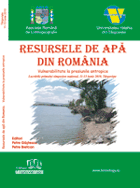11-13 June 2010. Water resources from Romania. Vulnerability to the pressure of man’s activities, Targoviste (Romania)

Resursele de apă din România. Vulnerabilitate la activităţile antropice
[Water resources from Romania. Vulnerability to the pressure of man’s activities]
Conference Proceedings
ISBN: 978-606-8042-65-7
11-13 June 2010, Targoviste - Romania
Editors
Petre Gâştescu
Petre Breţcan
MANAGEMENTUL SITUAŢIILOR DE URGENŢĂ GENERATE DE INUNDAŢII ÎN ROMÂNIA
Olimpia NEGRU, Simona PĂTRUŢ, Ana-Maria ŢONE
Ministerul Mediului şi Pădurilor, Bdul. Libertăţii nr. 12, sector 5, Bucureşti, e-mail: olimpia.negru@yahoo.com,
MANAGEMENT TO EMERGENCIES SITUATIONS GENERATED TO THE FLOODS IN ROMANIA
Abstract: Torrentiality relatively high degree of water courses, determined by climatic conditions and physical-geographical factors make the floods to be a common phenomenon in Romania. This has generated particular interest demonstrated both in theoretical approach to the phenomenon, the level of education and research, and practical in ensuring and improving the legislative framework, legal provisions and effective implementation of action plans and through work hydrotechnichal important for mitigating flood waves, reducing damage caused by them, as well as flood risk. In the last decade, virtually every year in our country have been major floods during which there have been big casualties and material damage. In Romania, floods as natural phenomena are the most common disasters and extreme floods such as 1970, 1975, 2005 and 2006 were marked and profound development of human society marks leading to a change strategy for finding the most appropriate solutions in defense against floods and their prevention. Major floods occurred during December 1995-January 1996 in the catchment Cris, Somes, Mures, in April 2000 in the catchment Crasna River and Mures in March 2001 and Tisza basin in July-August 2002 in the catchment Siret. But most important were those recorded floods in 2005, it was only the last 100 years occurred on a very long time (February-September) and enlarged areas - catchment Timis, Bega Bârzava , Caras, Nera, Siret, Ialomita. There have been historical flow rivers of Banat, the rivers Trotus, Putna, Cricovul Sarat. During April-May 2006 showed the greatest flood on the Danube river, comparable to that recorded in 1895. Today in Romania amid increasing social responsibility, they speak of flood risk management, realized coordinated by all responsible. Floods cause considerable damage and displacement of large numbers of people. They also produce great damage infrastructure, private property and economic objectives and environmental. In terms of trends, highlights two factors increase risk in Europe. First, the result of climate change and secondly because residential areas and economic objectives in areas at risk from flooding. World practice has shown that the occurrence of floods can be avoided, but they can be managed and their effects can be reduced through a systematic process leading to a series of measures and actions to help mitigate the risk associated with these phenomena.
© Asociatia Romana de Limnogeografie (2008)

